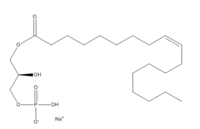This is a default text for your page '. Click above on edit this page' to modify. Be careful with the < and > signs.
You may include any references to papers as in: the use of JSmol in Proteopedia [1] or to the article describing Jmol [2] to the rescue.
Lysophosphatodic Acid
Structure
Comparison of S1P and LPA
Lysophosphatidic Acid Receptors (LPA) are part of a larger family known as lysophospholipid receptor family (EDG family). Within this family there is a structure called S1P1. Since only the structures for LPA1 and S1P1 are known in the EDG family, comparisons are made between the two structures.
There is a difference in binding paths between these two receptors. The binding path in the LPA1 is located in the extracellular milieu. While in the S1P1 the ligands are able to have access to the membrane so that the binding can occur. There is a difference in the shape of the electron density from the binding pocket. In S1P1 the binding pocket has more of an oval shape. For the LPA1 receptor the binding pocket has a spherical shape. Since the binding pocket is more spherical it gives LPA1 the ability to be able to recognize a larger group of chemical species. In particular the ability to bind with acyl chains of varying lengths.

A comparison of the binding pockets of LPA1 vs. S1P1
Function
Relevance
Clinical Testing
This is a sample scene created with SAT to by Group, and another to make of the protein. You can make your own scenes on SAT starting from scratch or loading and editing one of these sample scenes.


